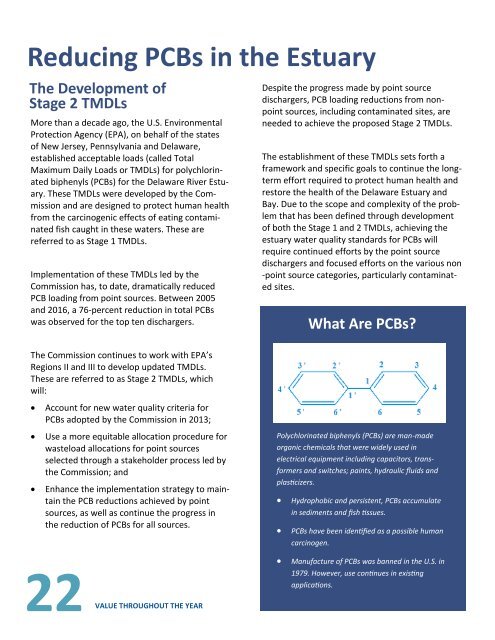2017 Annual Report of the Delaware River Basin Commission
Create successful ePaper yourself
Turn your PDF publications into a flip-book with our unique Google optimized e-Paper software.
Reducing PCBs in <strong>the</strong> Estuary<br />
The Development <strong>of</strong><br />
Stage 2 TMDLs<br />
More than a decade ago, <strong>the</strong> U.S. Environmental<br />
Protection Agency (EPA), on behalf <strong>of</strong> <strong>the</strong> states<br />
<strong>of</strong> New Jersey, Pennsylvania and <strong>Delaware</strong>,<br />
established acceptable loads (called Total<br />
Maximum Daily Loads or TMDLs) for polychlorinated<br />
biphenyls (PCBs) for <strong>the</strong> <strong>Delaware</strong> <strong>River</strong> Estuary.<br />
These TMDLs were developed by <strong>the</strong> <strong>Commission</strong><br />
and are designed to protect human health<br />
from <strong>the</strong> carcinogenic effects <strong>of</strong> eating contaminated<br />
fish caught in <strong>the</strong>se waters. These are<br />
referred to as Stage 1 TMDLs.<br />
Implementation <strong>of</strong> <strong>the</strong>se TMDLs led by <strong>the</strong><br />
<strong>Commission</strong> has, to date, dramatically reduced<br />
PCB loading from point sources. Between 2005<br />
and 2016, a 76-percent reduction in total PCBs<br />
was observed for <strong>the</strong> top ten dischargers.<br />
Despite <strong>the</strong> progress made by point source<br />
dischargers, PCB loading reductions from nonpoint<br />
sources, including contaminated sites, are<br />
needed to achieve <strong>the</strong> proposed Stage 2 TMDLs.<br />
The establishment <strong>of</strong> <strong>the</strong>se TMDLs sets forth a<br />
framework and specific goals to continue <strong>the</strong> longterm<br />
effort required to protect human health and<br />
restore <strong>the</strong> health <strong>of</strong> <strong>the</strong> <strong>Delaware</strong> Estuary and<br />
Bay. Due to <strong>the</strong> scope and complexity <strong>of</strong> <strong>the</strong> problem<br />
that has been defined through development<br />
<strong>of</strong> both <strong>the</strong> Stage 1 and 2 TMDLs, achieving <strong>the</strong><br />
estuary water quality standards for PCBs will<br />
require continued efforts by <strong>the</strong> point source<br />
dischargers and focused efforts on <strong>the</strong> various non<br />
-point source categories, particularly contaminated<br />
sites.<br />
What Are PCBs?<br />
The <strong>Commission</strong> continues to work with EPA’s<br />
Regions II and III to develop updated TMDLs.<br />
These are referred to as Stage 2 TMDLs, which<br />
will:<br />
• Account for new water quality criteria for<br />
PCBs adopted by <strong>the</strong> <strong>Commission</strong> in 2013;<br />
• Use a more equitable allocation procedure for<br />
wasteload allocations for point sources<br />
selected through a stakeholder process led by<br />
<strong>the</strong> <strong>Commission</strong>; and<br />
• Enhance <strong>the</strong> implementation strategy to maintain<br />
<strong>the</strong> PCB reductions achieved by point<br />
sources, as well as continue <strong>the</strong> progress in<br />
<strong>the</strong> reduction <strong>of</strong> PCBs for all sources.<br />
Polychlorinated biphenyls (PCBs) are man-made<br />
organic chemicals that were widely used in<br />
electrical equipment including capacitors, transformers<br />
and switches; paints, hydraulic fluids and<br />
plasticizers.<br />
• Hydrophobic and persistent, PCBs accumulate<br />
in sediments and fish tissues.<br />
• PCBs have been identified as a possible human<br />
carcinogen.<br />
22 VALUE<br />
THROUGHOUT THE YEAR<br />
• Manufacture <strong>of</strong> PCBs was banned in <strong>the</strong> U.S. in<br />
1979. However, use continues in existing<br />
applications.





